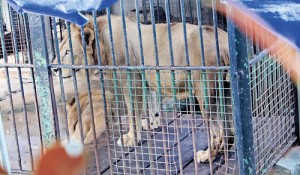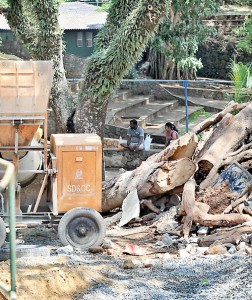News
Zoo with no heart leaves visitors cold
The Dehiwela zoo, which has drawn millions of local and foreign visitors since opening 70 years ago, is losing its attraction due to the poor care of animals, renovations hampering visitor activities and the removal of some animals to Hambantota.

The two old Lions in their cage. Pix by Anuradha Bandara
Visitors said their visit to the zoo was a waste of money and that the animals should be well cared for and the facilities upgraded.
Mrs S. Ratnapala, from the Divisional Secretariat’s office in Dehiwela, said she had visited the zoo with a team for a research on butterflies and found that the butterfly room had only one butterfly, of a common species.
She said she would never visit the zoo again because of the poor state of animals and the state in which they are kept.
“This is a useless place which has no care for animals or conservation and we saw fewer animals than on previous visits. The zoo authorities were unaware that there were no butterflies. The people who come to educate themselves are left to stare at empty pens,” she said.
She said the landscaping was pretty but maintenance of cages was very poor and some aviaries as well as the Bird Safari Room did not have birds while the zoo kept charging Rs. 100 for tickets.
Anne Maria, a Russian tourist, said Sri Lankans were a good-hearted people but suggested this was not evident in our care of the zoo’s animals. “On arrival at the zoo they gave us a warm welcome and gave us maps of the zoo,” said said, “but animals must also be treated well.
“We saw lots of animals but we also saw some situations where two old lions were kept in a small cage – that was sad to see and is a sin,” she said.
The two lions live in a cramped 30 x 30-foot cage with a concrete floor and iron bars patched up in places with thin mesh. The floor was wet. The Sunday Times saw one lion urinating and then having to lie down on the urinated spot.

Ongoing construction work
The lions are about 15 years old. Lions in captivity live about 20 years or more. These two lions have been caged all their lives in the zoo. Initially they were placed with lionesses but when they grew too old to mate they were placed together.
Visitor Nanda Kumar said some pens were being reconstructed with the animals still in them.
The Sunday Times saw an example of this in the giraffe area, when the fence around the animals’ pen was being replaced with a moat; until this is completed the giraffes are trapped in a small area with a huge temporary fence.
Mr. Kumar criticised the lack of notices in some areas to inform people where animals had been removed or that there were renovations taking place.
“Children and even grownups would go near the cages under repair without knowing that a wild animal that could be dangerous or poisonous could break loose from a weak point of the cage,” Mr. Kumar said.
Kanchana Jayaratne, another visitor, said animals should be kept in a safari park and not in small cages as exhibits, and the elephants must be given a bigger area.
The elephants are chained to the concrete floor of a single pen. A lonely African elephant was kept apart from the others in a small space separated by a wall. This elephant, swaying from side to side with frustration, had a skin problem on its forehead and ears and back due to the unavailability of mud baths.
K.A.U. Kalumpriya from the Open University’s Zoological Department, who visited the zoo with several batchmates, said keeping animals in an unnatural environment increased deaths and mental disorders among the creatures.
The Director of the Zoological Gardens, Anura de Silva, said the zoo was being improved.
He said road systems and animals enclosures would expand and improved while some animals would be taken to the Safari Park in Hambantota.
He admitted that the deer enclosure needs to be grassed and was over-crowded but said there would be more room when some of the deer were taken to the Hambantota park.
He also admitted that some patched-up cages needed to be mended quickly given that the improvements were being carried out while the zoo was open to the public.
A Zoo Authority official said only African animals would be sent to the Hambantota safari park.
Environmentalist and researcher at the Biodiversity Conservation and Research Circle of Sri Lanka, Supun Lahiru Prakash commended moves that would result in the zoo animals being given more space. He said this would aid the animals physically and mentally.
He cautioned against introducing animals exchanged from a colder country. The warm climate and cramped spaces would cause stress to the animals and could kill them. They needed to be kept under close observation until they adapted to the new environment.

